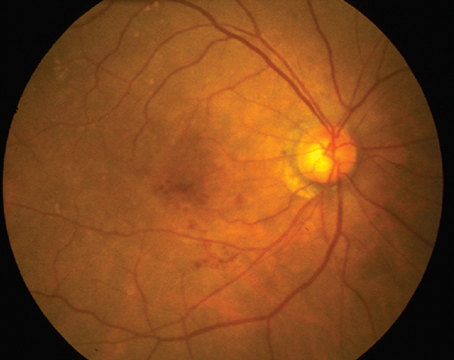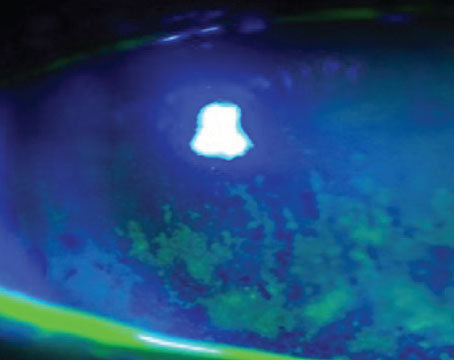
|
| Image courtesy of Getty Images |
The global health burden of age-related macular degeneration is projected to grow rapidly in the next two decades, due to the aging population. However, “The treatment for neovascular AMD is expensive and only sometimes effective,” says Valerie Kuan, PhD, of the Institute of Health Informatics, University College London. “There’s also no cure for the AMD subtype geographic atrophy.” She and her colleagues say that public health efforts directed toward prevention will be critical.
They recently published a study in JAMA Ophthalmology that provides genetic evidence that smoking and alcohol are associated with advanced AMD.1 “This lends strength to the premise that these risk factors may be causal for AMD,” she says.
The study employed a method called Mendelian randomization (MR), which Dr. Kuan explains, “is a method of using the association in the level of an exposure variable with genetic variants to examine the causal effect of a modifiable exposure on disease in observational studies.”
It’s based on a version of the transitive property of equality, where if a certain genetic variant causes a change in exposure to something that is causal for a disease (such as tobacco use), then that genetic variant is associated with the risk of disease.1 Genetic variants are used as natural experiments.2 They make good instrumental variables on the assumption that they associate with the risk factor; that they’re not related to confounders; and that they affect the outcome only through the risk factor.2
Mendelian randomization is particularly suited for identifying causal associations in age-related diseases such as macular degeneration, where exposure to risk factors and clinical manifestations of the disease may be separated by several decades. The method helps to reduce confounding or reverse causation and is more cost-effective than large-scale randomized clinical trials. It also steps in where RCTs fall short—it’s just not possible to conduct an RCT to pinpoint whether a specific exposure such as alcohol consumption is an actual modifiable risk factor.1,3 (For more information on MR, Dr. Kuan recommends a BMJ podcast that interviews the authors of a paper on reading and assessing MR studies for clinicians. Both can be found at bmj.com/content/362/bmj.k601.)2
Dr. Kuan’s study used two-sample MR, which further increases statistical power and allows for the use of very large datasets.2 From published genome-wide association studies, she and her team obtained genetic instruments composed of variants associated with AMD risk factors at genome-wide significance (p<5x10-8). They obtained summary-level statistics for the instruments for advanced AMD from the International AMD Genomics Consortium 2016 dataset, which included 16,144 subjects with AMD and 17,832 controls.
The researchers performed univariable inverse-variance-weighted two-sample MR analyses under a multiplicative random-effects model to assess the potential causal role of several exposures, including smoking, alcohol intake, body mass index, blood pressure and glycemic traits, on advanced AMD and its subtypes geographic atrophy and nAMD. They also performed multiple sensitivity analyses. Here are the key findings of the study:
- Genetic predisposition to starting smoking was associated with higher risk of advanced AMD (odds ratio [OR], 1.26; 95% CI, 1.13 to 1.4; p<0.001). They reported a similar association with nAMD (OR, 1.26; 95% CI, 1.11 to 1.43; p<0.001) but not with geographic atrophy (OR, 1.24; 95% CI, 1.03 to 1.49; p=0.02).
- Genetic predisposition to stopping smoking was associated with lower levels of advanced AMD than continuing to smoke (OR 0.66; 95% CI, 0.5 to 0.87; p=0.003).
- Genetic predisposition to lifetime smoking (measured by a composite index that accounted for smoking status, duration, heaviness and cessation) was associated with a higher risk of advanced AMD (OR, 1.32; 95% CI, 1.09 to 1.59; p=0.004).
- Genetic predisposition to higher alcohol consumption was associated with increased risk of geographic atrophy (OR 2.7; 95% CI, 1.48 to 4.94; p=0.001) but not with nAMD. The researchers say further studies are needed to find out why this is.
- They found no evidence that BMI, blood pressure, type 2 diabetes, HbA1c, fasting glucose level or fasting insulin level had a causal association with AMD risk.
“A large number of observational studies have shown an association between smoking and AMD, which we’ve confirmed in this study,” Dr. Kuan notes. “However, the evidence for alcohol has been less consistent. We’ve shown here a link between alcohol and geographic atrophy, which is important because there’s currently no cure for GA.”
Oxidative stress and damage are thought to be the mechanisms by which alcohol affects the retina. Alcohol depletes antioxidant levels and promotes production of reactive oxygen species.1 However, in moderation, it’s been reported to have some protective effects for AMD through decreased platelet aggregation, lower serum fibrinogen, C-reactive protein levels and increased high-density lipoprotein cholesterol levels.3
The study was limited by a relatively small dataset (e.g., compared to cardiovascular disease), which may have impacted its statistical power, even though it used the largest known advanced-AMD genome-wide association studies. Additionally, the estimates from MR studies must be interpreted carefully.1 Because genetic variants refer to lifelong differences in a risk factor, not effects of a clinical intervention at a specific point in time,2 the MR estimate is better interpreted as a test statistic for a causal hypothesis.1
What should clinicians tell their patients? “The message is prevention, not cure,” says Dr. Kuan. “It’s preferable to abstain from smoking (or stop smoking if you’ve started) and drink less alcohol if you want to lower your risk of developing AMD. Public health bodies should certainly be raising awareness that in addition to smoking leading to cancers and cardiovascular disease, and increased alcohol intake leading to liver damage, both of these activities can also lead to blindness. For some people, this might be a stronger deterrent.”
1. Kuan V, Warwick A, Hingorani A, et al. Association of smoking, alcohol consumption, blood pressure, body mass index, and glycemic risk factors with age-related macular degeneration: A Mendelian randomization study. JAMA Ophthalmology 2021. [Epub November 4, 2021].
2. Davies NM, Holmes MV, Smith GD. Reading Mendelian randomisation studies: A guide, glossary, and checklist for clinicians. BMJ 2018;362:k601.
3. Su X, Wong T. Revisiting the alcohol consumption association with age-related macular degeneration: What should we tell patients in 2021? JAMA Ophthalmology, Invited Commentary 2021. [Epub November 4, 2021].
The Blood Pressure/Glaucoma Connection
To assess the relationship between blood pressure and glaucoma, and learn whether or not medications play a part, researchers recently conducted a retrospective cohort study of a National Institutes of Health electronic health records database.1 They pointed out that the program is uniquely suited to studying glaucoma risk factors, as it offers comprehensive, longitudinal health information for more than a quarter of a million patients in the United States. They included patients with at least 15 months of follow-up and one BP measurement.
A total of 20,815 patients qualified for the study; of these, 462 developed OAG. The researchers reported that low BP, defined as mean arterial pressure (MAP) lower than 83 mmHg, was associated with an increased risk of developing OAG. High BP (MAP >101.3 mmHg) and the number of BP medication classes, on the other hand, weren’t associated with OAG after the researchers adjusted for covariates.
They also reported elevated risk among those who were Black, Hispanic, Latino, Asian, older and/or diabetic. Additionally, female sex was associated with a decreased risk of OAG development. They noted no significant interaction between arterial pressure and the number of BP medications on the risk of OAG development.
The researchers noted that though MAP didn’t differ significantly between patients who developed OAG and those who didn’t, its effect on OAG development was significant after controlling for confounding factors. “Increasing the number of BP medication classes appeared to be associated with increased hazard of developing OAG until other factors were adjusted for in multivariable regression,” they said. “These results suggest that all other factors being equal, lower BP is associated with increased risk of developing incident OAG.”
Other studies, such as the Rotterdam Study, Egna-Neumarkt Study and Beaver Dam Eye Study, have noted a positive association between hypertension and increased IOP, but they haven’t demonstrated a corresponding increase in development of open-angle glaucoma. “These studies were cross-sectional in design and couldn’t measure the risk of developing incident OAG,” the researchers note in their paper, published in Ophthalmology. “Furthermore, these studies were composed of ethnically homogenous populations, so it’s unclear if their results can be broadly extrapolated to the general population.”
Consistent with their study’s findings, several longitudinal, population-based studies have identified an association between low BP and increased risk of OAG. These include the four- and nine-year follow-up data of the Barbados Incidence Study of Eye Diseases, which initially found a positive correlation with systolic BP and increased IOP, but upon further analysis of systemic hypertension, the study noted a negative association between hypertension and risk of OAG development. Also, the Early Manifest Glaucoma Trial’s 11-year follow-up data showed that higher systolic BP (>160 mmHg) was protective against OAG progression.
The researchers say that, like the present study, the design of these previous longitudinal studies allows the measurement of incident glaucoma and identification of risk factors for incident glaucoma. They say that their results expand on the literature that points to systemic hypotension as a risk factor for incident open-angle glaucoma development.
Additionally, the researchers pointed out that this study is the first to examine the difference between therapeutically low and naturally low blood pressure on the risk of open-angle glaucoma development. “Since no significant interaction was identified between MAP and the number of BP medication classes on development of OAG, we didn’t find that low blood pressure due to blood pressure medication use confers a different risk of developing OAG compared with naturally low BP.
“Like previous epidemiological studies,” the investigators continue, “the associations described in this study don’t provide conclusive evidence with regard to causation of glaucomatous disease, but rather add to the evidence supporting vascular risk factors as possible contributors to OAG pathogenesis. In the vascular dysregulation hypothesis of OAG, the relationships between BP, IOP and ocular perfusion pressure are implicated in adversely impacting ocular blood flow and thus damaging the optic nerve.”
The researchers stress that although BP is a modifiable risk factor, the findings of their study “should by no means lead to a broad reduction in the treatment of hypertension in an effort to reduce glaucoma risk. The associated risk of incident open-angle glaucoma with hypotension, while statistically significant, would not likely outweigh the risks of uncontrolled hypertension. Further confirmation, including a better understanding of the pathophysiology of OAG, is necessary before adjustment of hypertension management for OAG prophylaxis can be considered.”
1. Lee EB, Wendeng H, Singh K, et al. The association between blood pressure, blood pressure medications, and glaucoma in a nationwide electronic health records database. Ophthalmology; October 21, 2021. [Epub ahead of print].





